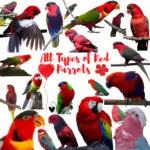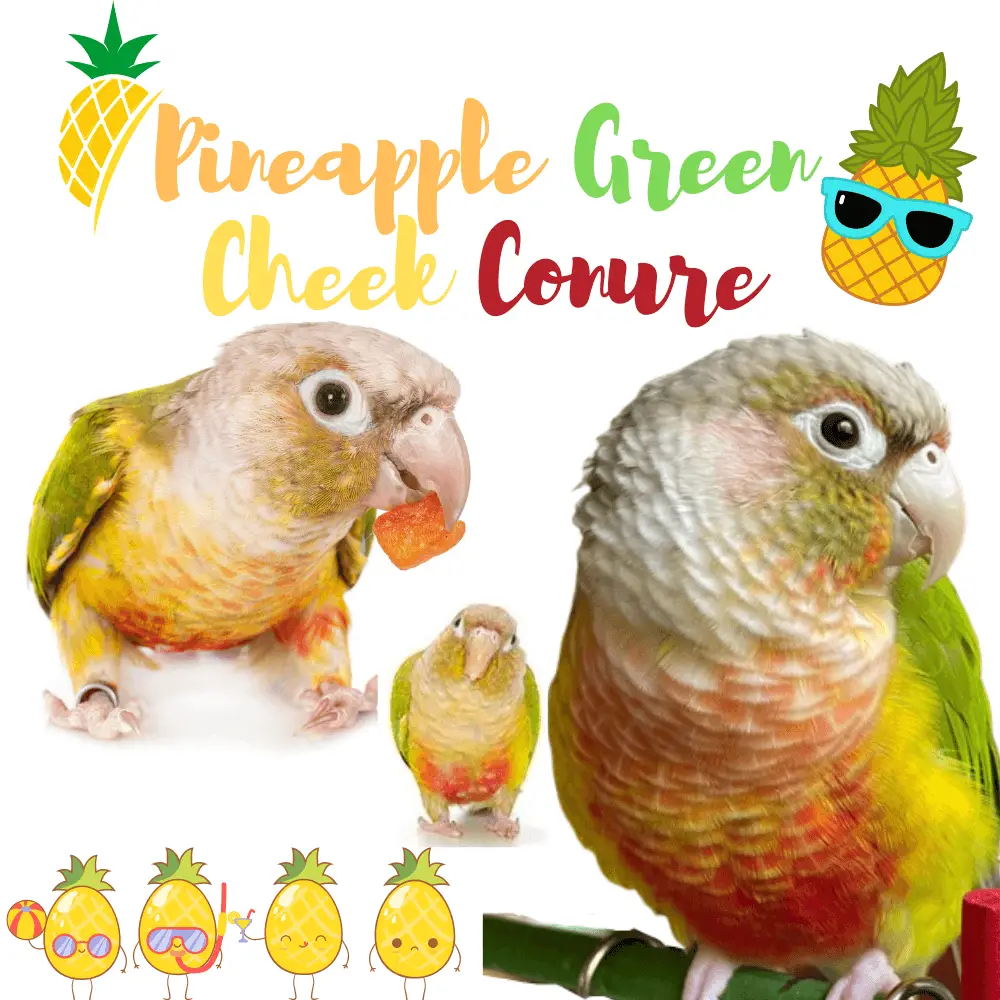
All about the Pineapple green cheek conure: The Pineapple Conure is a beautiful variation of the Green-cheeked Conure which was born from a conure-type mutation of the Cinnamon Conure and the Yellow-sided Conure. This unique combination gives them a colorful appearance that makes conure popular pets among birds and parrot lovers.
Their small size is another reason for their popularity. Their playful character, intelligence like the other big parrot African Grey Parrot, Amazon Parrot, Macaw Parrot, Cockatoo parrot, Eclectus Parrot, and tranquil nature add to their appeal. They are friendly little birds that need attentive and loving owners.
Pineapple Conures in the wild
Pineapple Conures are native to the wilderness of South America. They can be seen in the forests and woods of Bolivia, Mato Grosso, Argentina, Brazil, and Paraguay. Because they are social, they can be found at the top of trees in flocks of 10 to 20 people or more, depending on the availability of food. The more food there is, the larger the herd they will form.
Physical attributes of pineapple conure
The physical characteristics of pineapple conures make it possible to know whether the owner is ready to keep them as pets or not. The purchase decision of a relative bird is usually based on certain criteria such as size, color, ease of handling.
Height and weight
Pineapple Conures are considered small species of Conures, with adults reaching a size of around 10 inches. The weight of an adult Pineapple Conure can vary between 60 and 80 grams.
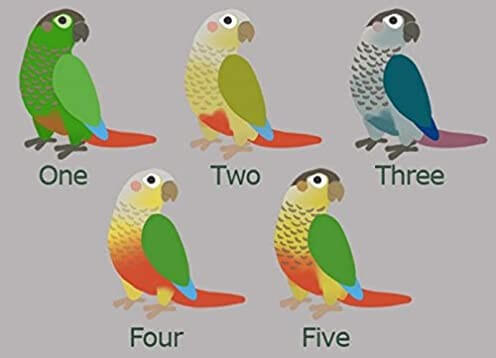
Pineapple Conure Color
As the Pineapple Parakeet is a mutation of the Cinnamon Parakeet and the Yellow-faced Parakeet, the colors of these two mutations are dominant in Pineapple Parakeets. Their head is tawny and their sides are yellow. The back feathers are green like those of the Cinnamon Parakeet and the chest is full of red and yellow colors. A reddish-orange color is usually seen around the lower feathers of their beak. Likewise, a few pops of red can be seen above their cereal. The tail feathers range from light red to maroon, just like the Yellow-sided Conures, and exhibit a halo effect. Their eyes are ruby red like those of Cinnamon Parakeets.
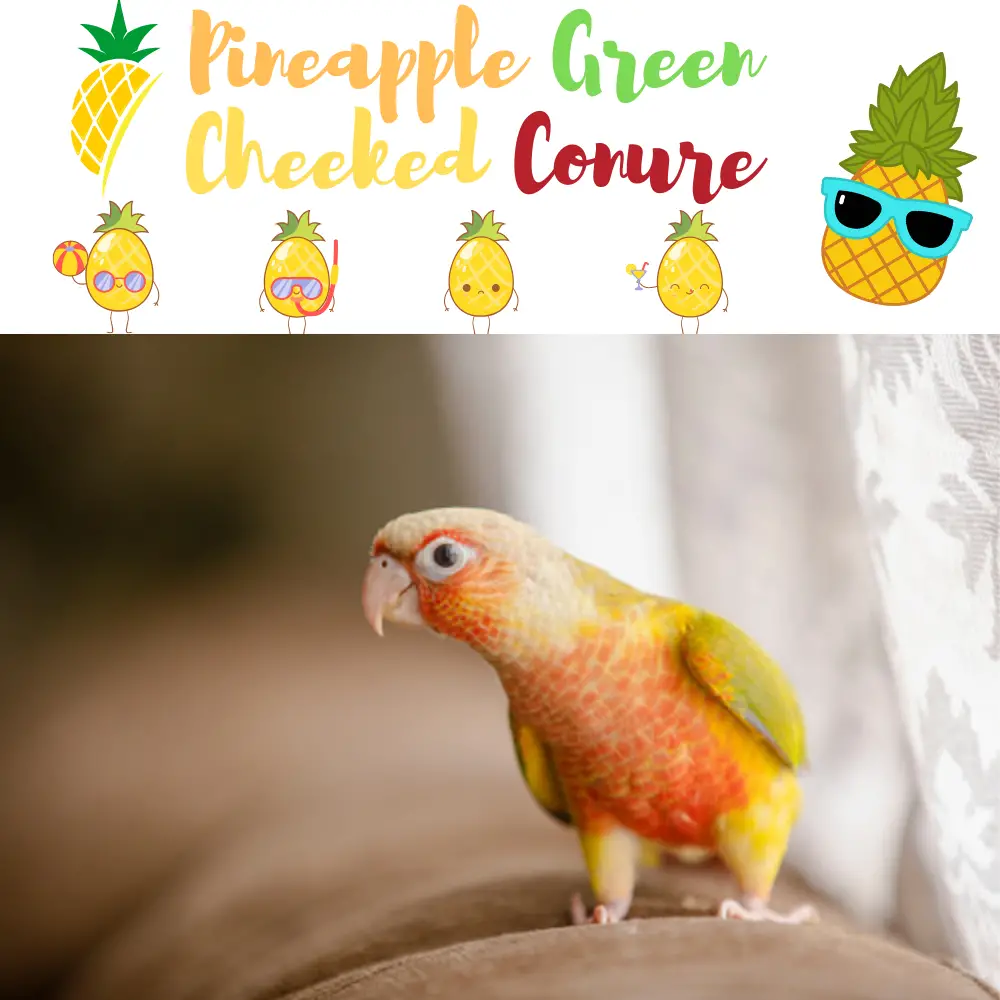
Pineapple Conure Sex Differences
Talking about the physical differences between the sexes of Pineapple Conures, they have a similar outward appearance. You can’t tell the difference just by looking at them. There are, however, a few behavioral differences that many Pineapple Conure owners notice between males and females. The Pineapple Conure Males tend to be more aggressive and territorial than females. They are also more adventurous. The females, on the other hand, are more cuddly and gentle.
Is my pineapple conure a boy or girl?
Simply put, you can’t tell a conure’s gender by looking at it. To affirmatively know the sex of a conure, you can order a DNA test kit, which involves sending in a couple of drops of blood or a few molted feathers. Of course, if the conure lays an egg you can be sure that she is female.
Pineapple Conure Character Attributes
Pineapple Conures have a strong personality in their small body. They are known as excellent pets for their sense of humor and their many wonderful character traits. To decide whether or not to keep a Pineapple Conure as a pet, it is essential to fully understand its behavior. We have tried to cover here some major aspects of the personality of the Pineapple Conure
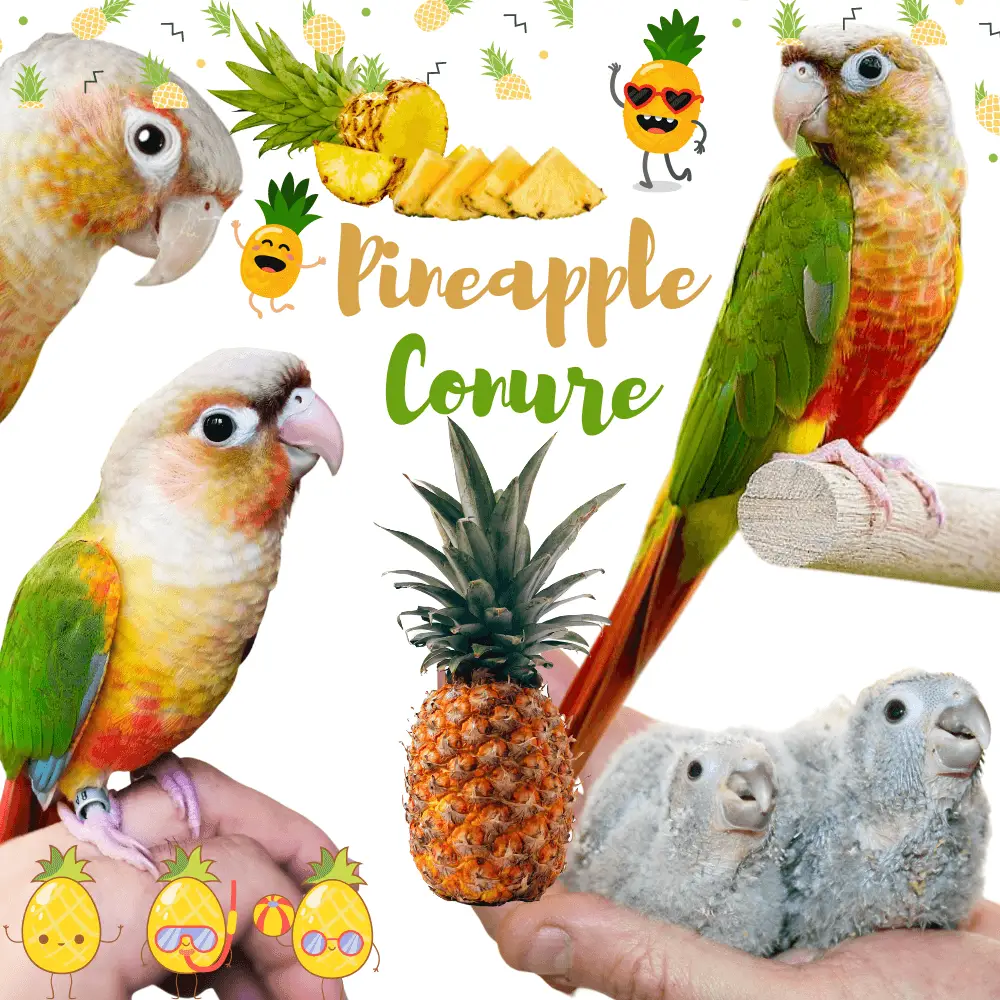
Pineapple conure behavior
Pineapple Conure is among the quietest species of Conure and can even be kept as pets in an apartment. That doesn’t mean they’re boring at all. On the contrary, they are playful and want their owners to hug them to show them their affection. They are intelligent and affectionate, which makes them excellent companions for pets.
These Conures roll on their backs to play or sleep and like to be scratched by their owner. They would also like to fight with their favorite human. Young pineapple conures are a bit biting and can bite their owners, but this behavior can be cured by proper training. These bites can also continue on the surrounding furniture, which complicates the task of the owners of these beauties.
Their small size does not prevent them from behaving like their larger cousins, macaws. They are very active and do extremely funny antics, such as dancing, shaking, kissing and hanging upside down.
If they do not receive the necessary attention, these birds are known to develop behavioral problems and become quite aggressive. This can lead the pineapple conure to stress and depression. In this case, this problem must be tackled immediately.
Pineapple Green Cheek Conure Temperament
The temperament of pineapple conure is rather relaxed and fun. They are extremely interactive and full of life, which is evident in their playful behavior. They don’t pass for real Conures because of their calm nature, which makes them perfect for people who are looking to own a Conure for their personality traits but aren’t ready to put up with the noise.
Being clownish is their second nature. They have a unique way of shaking and dancing to entertain the people around them, which adds to everyone’s fun. Although pineapple conures have different personalities, they all become aggressive if they don’t get enough hugs. They usually want their owners to rub their necks, stomach, and head. In return, these little birds climb on the roof of the house.
Pineapple Conures are quite energetic throughout the day, so their extra energy must be directed to their favorite activity: gambling. These clowns from the world of birds love to hang upside down and can do it without getting tired. Thus, a good variety of strings will allow them to have fun. A good variety of wood and toys offered at Pineapple Conures will prevent the appearance of any behavioral problems.
The pineapple conure parrot love to:
- Swing off their perches
- Go in and out of things
- Lay on their backs
- Hang upside down
Do conures like to be held?
Conures love being held and picked up, but they need a gentle and firm hand. You can put your hand out and let the conure step up onto your hand. Then it may climb your arm or move to your shoulder.
Do conures get attached to one person?
These conures are more likely to be family birds, and not as likely to be bonded to just one person, so there are many situations where that is a positive trait. Conures have “big bird” traits and personalities in small bodies.
Do conures recognize their owners?
They Will Recognize You From a Distance Birds can see very well, but they have the ability to recognize their owner even when they’re out of sight. They have excellent peripheral vision and hearing that helps them notice when they’re not alone.
Why do conures preen me?
As mentioned, parrots preen their owners as a form of affection. If a parrot chews on your hair, ear, nose, or clothes, it’s because it likes and trusts you. Preening is a way for parrots to clean and maintain feather quality. Sometimes, a parrot will transfer these techniques to its owner’s hair.
What does it mean when a conure bobs its head?
The Birds Are Excited This rapid head movement is an indicator that the Conure is happy to see you. They’ll also bob their head if they are excited about something such as food or a treat they like. Most Conures also get happy when they hear music. They could start dancing as they bob their heads.
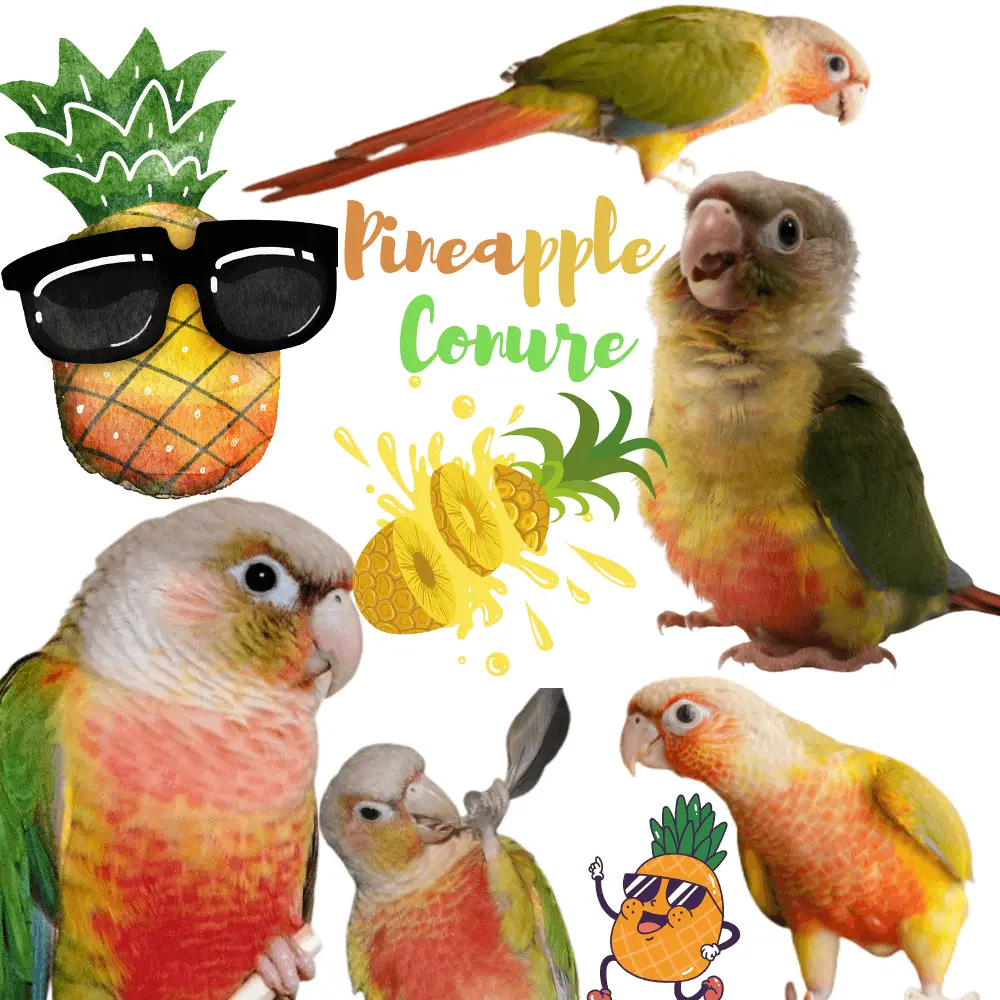
How do you bond with a pineapple conure?
- Always be sure to speak with your pineapple alone in a good place room without any destruction and always Keep your Voice Low and Inviting, very important Soft speech is important when meeting your new parrot.
- Take it Slow don’t go forward speedily because Sudden motions can also startle your parrot
- Offer your pineapple conure Their Favorite Treat Food Seed
- Offer Them Comfort after each good reaction, Comfort is very important to create a bond with your parrot
- Socialize with Your parrot, he is very smart just do it
- Play with Your parrot, because the pineapple conure is a very playful parrot so use this point to gain the score
- Be Patient Be Patient Be Patient Be Patient, the patient is the key to success.
How To Take Care of A Pineapple Green Cheek Conure
The pineapple green cheek conure parrot owner needs to know how to take care of their conures with healthy food good diet and much love. Find out how to keep your pineapple conure happy and healthy with this care guide.
Diet of the Pineapple Conure
As with all other species of parrots, diet is important for the good physical and mental health of pineapple conures. Their diet is varied and must be balanced for optimal nutrition.
Diet of pineapple Conure in the wild
In the wild, pineapple conures like to feed on various fruits, nuts, seeds, grass, and insects, including their larvae. Their favorite place to find food is treetops. In some areas, they also like to attack farmers’ crops.
Diet of pineapple conure in captivity
In captivity, Pineapple Conures eat what they are served. It is, therefore, the responsibility of the owner to give him a balanced diet.
Seeds
Are the favorite of Pineapple Conures and they love to gorge themselves on a wide variety of seeds. Give them quinoa, chia, and barley, or mix several to keep the bird interested. Soak them for a few hours before serving so that they can be chewed by the bird.
You can also serve them sprouted if the bird likes it. Do not abuse the seeds as they are high in fat and can cause obesity in pineapples. Also, do not try to give the bird a mixture of commercial seeds, as it contains a lot of fat and has an unbalanced nutritional profile.
Pellets
Make up the bulk of Pineapple’s diet and makeup about 65-70% of its diet. They are important because they contain everything that the bird lacks in its daily diet. With a balanced nutritional profile, granules are essential for Pineapple. Choose a high-quality brand available online or at any pet store.
Fruits
Are another favorite of pineapple conures, both in the wild and in captivity. Serve them a variety of fresh fruits like bananas, apples, grapes, pineapples, berries, blueberries, mangoes, pears, etc. These can be offered with or without the skin. Cut them into slices, diced or pureed before serving. The main thing is that they are easy to eat for the bird. Discard any fruit that has not been eaten for more than 5 to 6 hours. They may have developed germs.
Vegetables
Are the main source of greenery for pineapples in captivity. Offer green cabbage, beetroot, kale or watercress leaves, and spinach to add calcium to their diet. In addition to leafy greens, dark vegetables are a great way to meet the vitamin A needs of the bird. Serve them sweet potatoes, pumpkin, or winter squash in small bites.
Freshwater
Is essential to keep pineapple hydrated, especially in hot and humid weather. Be sure to regularly provide fresh water at any time of the day. And during the warm months, it is better to keep a backup bowl for the bird, in case the first one runs out. Serve only clean, safe drinking water. Change the water every few hours to maintain hygiene.
Cuttlefish bone
Is indispensable for the pineapple to have strong and healthy bones. The best is to hang the cuttlefish bone inside his cage, near a perch, so that he can chew it easily whenever he wants. The bird will be able to gnaw its beak and keep it in shape.
What Foods Are Bad for Pineapple Green Cheek Conures?
Conure toxic food: Never ever feed your pineapple conure parrot the following foods:
- Avocado
- Chocolate
- Milk
- Human junk food
- Coffee
- Sugar
- Fried food
- Hony
Pineapple Green Cheek Conure Health Problems
The pineapple conure is very prone to these illnesses:
Diarrhea or polyuria
The main signs of Diarrhea or polyuria disease in green cheek pineapple conures include:
- Loss of appetite
- Weight loss
- Vomiting
The classic symptoms of this disease are what are called the four Ps.
- Polyuria ( overproduction of urine )
- Polydipsia ( intense thirst )
- Polyphagia ( increased appetite )
- Weightloss
Chlamydiosis
The main signs of chlamydiosis disease in green cheek pineapple conures include:
- Appetite loss
- Difficulty moving or flying
- Fluffed feathers
- Lime droppings
- Coughing
- Beak discharge
- Pink eyes
Polyomavirus
The main signs of polyomavirus disease in green cheek pineapple conures include:
- Sudden death
- Loss of appetite
- Weight loss
- Vomiting
- Lethargy
- Swollen abdomen
- Regurgitation
- Breathing difficulties
Psittacine Beak Feather Disease
The main signs of psittacine beak feather disease in green cheek pineapple conures include:
- Claw and Beak deformities
- Yellow contour feathers on green parrots
- Sudden death
- Secondary infections
Psittacosis
The main signs of psittacosis disease in green cheek pineapple conures include:
- Weight loss
- Watery, Swollen, crusty eyes
- Reduced vocalization
- Depression
- Discharge from eyes and beak
- Yellow or green droppings
- Reduced appetite
- Weakness
Aspergillosis
The main signs of aspergillosis disease in green cheek pineapple conures include:
- Fluffed feathers
- Tail bobbing
- Weight loss
- Listlessness
Pineapple conure price
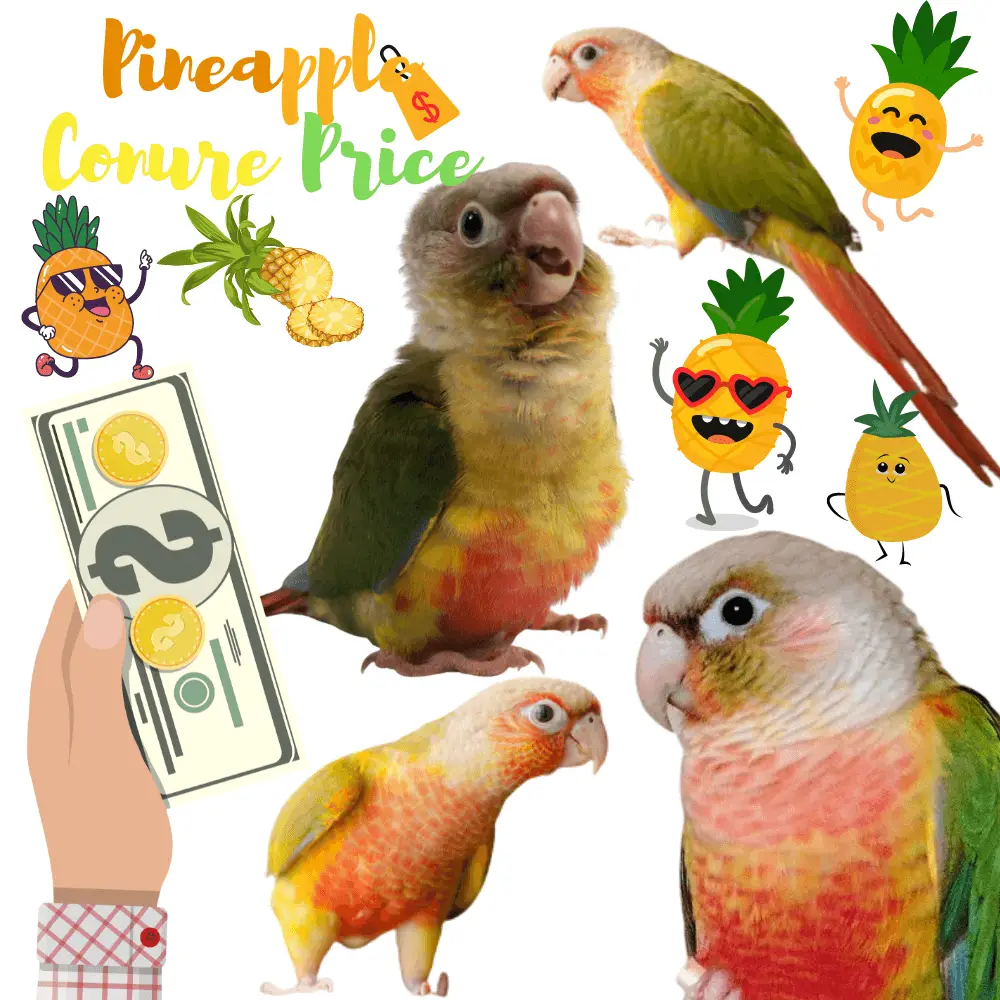
How much does a pineapple conure cost? Conures Can Be Easy To Find Green-cheeked conures have an average price range of $250 to $450, according to Whittaker, with breeders likely cheaper and pet stores being more expensive.
For the price of a pineapple conure parrot, you can expect to be from $250 to $600
What is the cheapest conure to buy?
The pineapple green cheek conure price is $250 to $600.this is the Factors that affect the price:
- The conure Age
- The conure Gender
- The conure health, Hereditary diseases
- The conure Genes
- The conure Breeder’s reputation
For one, you will need to buy the bird, with its price depending on the breeder, the bird’s age, quality, geographical location, mutation, and colors. However, you can expect the Green Cheek Conure price to be from as low as a cost of $150 to as high as $600.
How smart is the pineapple conure?
They are intelligent and capable of learning multiple tricks. They are not especially good talkers but can learn some speech. the pineapple conure is a very very playfulness and acrobatics bird he loves to do some tricks and play around.
The pineapple Green cheek conure can learn some tricks like :
- Free fly outdoor
- Waving
- Shaking hands
- Turning around
Is pineapple conure playful?
Are pineapple conures playful? They are affectionate, and playful, and enjoy spending time with their owners. However, they can also be disturbing and a nuisance at times, but compared to most birds, they are generally considered to be quite accommodating, with their uncooperative nature not being a constant thing but small bursts
Why does my conure hang upside down?
This might be observed when your bird is sleeping, playing, eating, or drinking. The truth is, this is normal and natural behavior for birds and should not be a cause for worry. It’s frequently reported in healthy parakeets, parrots, and cockatiels. the upside-down parrot can be a good sign for a good healthy bird and good mood bird.
Can you potty train conures?
Parrots learn quickly, and tame parrots can be potty trained no matter their age. Potty-trained parrots can make better house pets on a long-term basis, and the habit can be developed in as little as 72 hours.
Pineapple Conure Ability to talk
Can pineapple green cheek conures talk? yes, The turquoise conure can learn to mimic human speech. and which parrot can speak? and how and why pineapple conure parrots talk also why do pineapple conure parrots’ eyes dilate when they speak? and what is the cheapest parrot that speaks?
Make your Pineapple green cheek conure parrot talk
Pineapple Conures are not great talkers. Their ability to speak can be compared to that of parrots, as they are both usually silent but can learn a few words. Since their voice is quite hoarse and deep, they are not the best birds to develop their ability to speak.
Although their vocabulary remains limited, they will make efforts to imitate human language if they are well encouraged. Their love for human interaction helps them learn to speak when their owners spend enough time teaching them. However, this ability varies greatly from one bird to another. Some will learn more, others will not.
Green Cheek Conure Ability To Talk.
Do pineapple green cheek conures talk?
Can a Green-Cheeked Conure talk? Yes, Green-Cheeked Conures can be taught to say a few words. They’re not the best birds for talking because their voice is slightly gravelly but they can mimic some human speech.
Pineapple Conure talk and says stop it
SOURCE:Peekaboo Parrots
What Sounds Do Pineapple Conure Make?
The pineapple conures aren’t loud parrots, but they can develop screaming behavior if the owner doesn’t spend enough time with them and doesn’t play with them.
Pineapple green cheek conure is not a quiet parrot, he is a lite bit noisy he makes sounds to get the owner’s intention and to show happiness he loves to:
- Clicking
- Singing
- Laughter
- Whistling
- Beak Grinding
- Chatter
What is the lifespan of a pineapple conure?
The lifespan of pineapple Green Cheek conures varies from 10 to 30 years, and sometimes with healthy food can live more than 35. The lower limit is normally observed in nature and in cases where these beauties are neglected by their owners. In captivity, the average parrot lifespan of this species is usually 15 years. But according to the experience of many owners of Conure pineapple, they can easily live up to 30 years. This feat is quite easy to achieve with proper care, attention, and diet for the bird. This species can even survive for more than 30 years with an attentive and loving owner.
In captivity, a healthy pineapple conure can live for as long as 30 years. This is about the upper limit of their lifespan, though in the wild they would very rarely get anything close to that old. It depends on a lot of factors even in captivity, but the healthiest pineapple conure could live for 3 decades.

Reproduction of the Pineapple Conure
The reproductive age of Pineapple Conures varies from 1 to 3 years. Female pineapples can reach maturity at about 7 months of age, but they should not be allowed to breed until the end of their first year. Such early reproduction could harm their health.
The breeding season of Pineapple Conures is summer in their natural habitat, which coincides with the month of February. In captivity, owners of Pineapple Conures can observe breeding behaviors during this period. Females tend to hide more often in the nest box. Both sexes can be seen regurgitating food and biting under the middle of the back. All these signs indicate that pineapple conures are ready to mate.
The average size of the clutches of this species is between 4 and 6 eggs, with exceptions for larger clutches. Male and female pineapple conures share the task of staying on the eggs for 22-25 days. If, in any case, none of the parents sits on the egg 10 days after laying, the egg does not hatch.
Cage requirements for Pineapple Conure
With their small size, Pineapple Conures do not need as much space as many species of large parrots. But, given their playful nature, a 22- to 24-inch square cage with a height of about 30 inches would do the trick for these creatures. Keeping a space of 1/2 to 3/4 inches in the metal bars is best for these cages. Such flight cages are comfortable for pineapple conures and provide them with adequate space for physical activity.
Adding cage accessories to the cage of the pineapple conure parrot is a necessity. Pineapple Conures are curious and cheerful in nature and could get bored without the addition of accessories.
Read more about the Location And Maintenance of the Parrot Cage
What Size Cage Does A Pineapple Green Cheek Conure Need?
The pineapple conure parrot needs a medium cage, not a smaller cage because they’re small the pineapple green cheek conure loves to fly all day, so for that Choose a cage that’s at least 60 x 60 x 60.
And put in the cage
- Food
- Water
- Toys
- A nesting box
- Playing and roaming
See More about how to keep a parrot safe out of its cage
Should you cover the conure cage at night?
Should we cover the parrot’s cage at night: As long as a dark, quiet, and somewhat secluded area is provided for a bird to sleep in, most will be fine without being covered at night. Remember, however, that sleep is vital to a bird’s well-being. If you are in doubt about your pet’s reaction to being uncovered, play it safe and resume covering the cage at night.
Which conure is the best pet?
White-Eyed Conure The White-Eyed Conure only lives about 20 years, but they make some of the best pets of any type of Conure. This is because of their docile nature which makes them more well-behaved than other parrots.
What is the loudest conure?
Nanday Conure You’ll notice that many of the loudest birds have chirps that suit their native habitat of tropical areas. The Nandy Conure has a chirp that reaches 155 decibels, comparable to the level of firecrackers. It is an exotic-looking pet bird that can also learn tricks and how to talk.
Summary
Pineapple conure is famous among bird lovers, especially those who wish to adopt a species of conure whose sound level is rather low. With a behavior no less playful and sociable-crowned-conure, the Conure pineapple makes a tough competition for all its cousins nowadays. They are becoming the favorite pet parrot of many people, thanks to the loyalty and love they show.
Related Articles:


